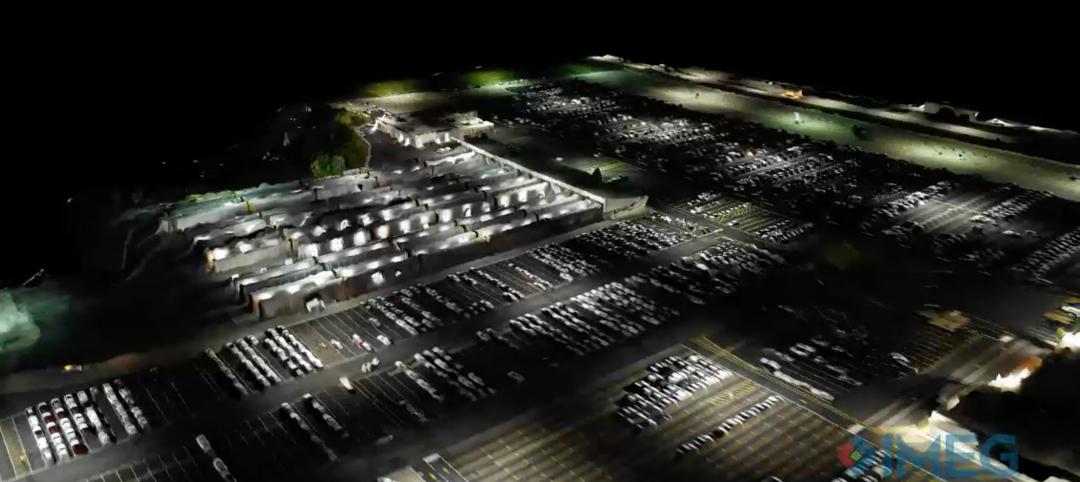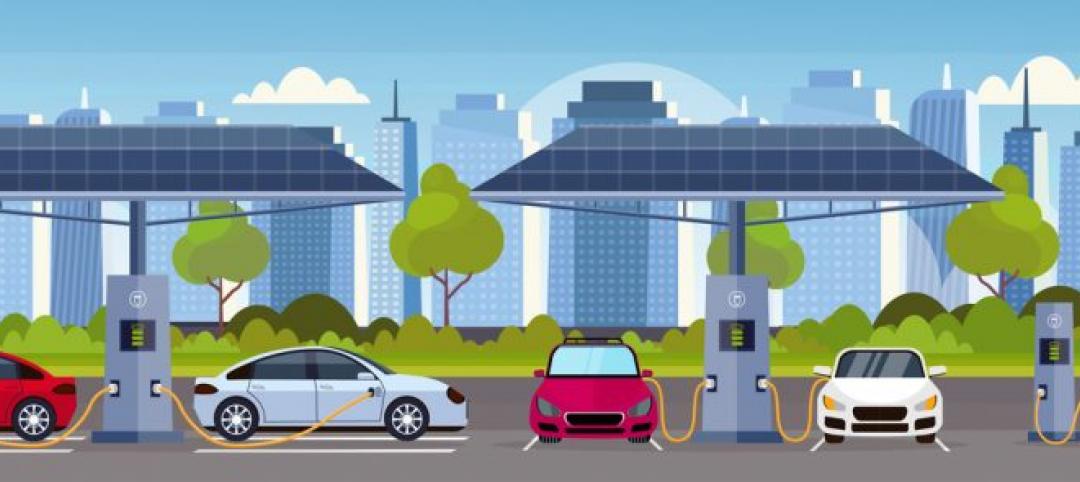Biophilic design, microgrids, and decarbonization—these are three of the trends, technologies, and strategies IMEG’s market and service leaders believe are poised to have a growing impact on the built environment. Read on to learn more about what owners, designers, and end users can expect to see more of in 2023 and beyond.
1. Industrialized construction
High-volume off-site construction, prefabrication, and on-site construction automation will continue to advance in response to ongoing labor and material challenges. This will lead to reduced costs, increased quality control, and the potential for improved energy efficiency and decarbonization. — Mike Lawless, Senior Director of Innovation
2. Biophilic design
A broader cultural shift toward health and wellness is reflected throughout the design industry in the growth of biophilic design. In lighting, for example, innovative new luminaire designs incorporate unexpected materials or integrated organic elements such as petrified moss and living plants. Manufacturers also showcase biophilic design concepts by continuing to have options available for luminaires designed for circadian support lighting as well expanding the breadth of integrated acoustic luminaires to include soft flowing shapes. — Shanna Olson, Architectural Lighting Leader
3. Sustainability and wellness in hospitality
Sustainability—from resource conservation to locally sourced foods—will be among the top trends in the hospitality industry as owners seek to reduce their carbon footprint and appeal to environmentally conscious guests. An uptick in wellness also is on the horizon, from resorts that offer health-focused stays and programming (think diet and nutrition, procedure recovery, rehabilitation, meditation, and fitness) to hotels offering a healthier indoor environment through improved air quality and ventilation, purified water, enhanced lighting for circadian rhythm, and biophilic strategies. — Bob Winter, Director of Hospitality
4. Decarbonization of healthcare
With the healthcare industry accounting for a yearly average of 5% of the carbon emissions of industrialized nations, many owners, architects, and engineers have already made commitments to reduce, and eventually eliminate, the carbon footprint of their healthcare building projects. — Mike Zorich, Vice President of Healthcare
5. Microgrid electrical systems
This free-standing, backup power source will become increasingly attractive to healthcare organizations and owners of other building types that require uninterrupted 24/7 power. The technology ensures resiliency during long-term power loss from the grid and eliminates reliance on backup generators and the fuel they require. — Brian Leavitt, Director of Electrical Engineering
6. IRA-incentivized green building
As the federal government provides more direction on the provisions of the Inflation Reduction Act (IRA) of 2022, owners and developers will begin taking advantage of the $369 billion included in the IRA for climate resilience, energy efficiency, and decarbonization-related technology. Look for the act to spur the greening not only of buildings and infrastructure in the federal, state, municipal, and university sectors, but also in the private. — Steve Rhoades, Vice President of Market Development & Federal Solutions
7. Meeting equity
This will become the standard in office spaces to enable all participants, regardless of their location and platform, to be equally heard and seen via smart AI cameras, beamforming mics, and auto-framing to identify participants and create a more natural experience. In the education market, new “Hy-Flex” classrooms will incorporate design elements supporting in-person and remote learning and lecture capture utilizing networked ceiling mic array systems, AI cameras, and multiple displays mounted around classrooms. — Mark Bradley, Project Executive, Technology
8. Building with SpeedCore
This concrete-filled composite plate shear wall can be used for constructing a building’s core, and, unlike a traditional concrete shear wall, it does not require internal reinforcing. Under the right circumstances, the revolutionary building method can reduce commercial high-rise construction time by one-fourth or more. — Wally Ford, Client Executive, Structural
9. Active shooter response training
An increasing number of corporations, schools, and healthcare organizations are tackling the issue of workplace violence by creating effective prevention programs and teaching their employees how to respond to emergencies quickly and correctly. With this training, any threat or emergency an organization may encounter can be better managed and less traumatic for employees. — Ryan Searles, Security Consulting Group Leader
10. Geospatial data analysis
Geographic information systems (GIS), subsurface utility engineering (S.U.E.), and reality capture technology will continue to improve the ability of civil engineers and surveyors to map, visualize, and analyze geospatial data, whether it’s outdoors or inside. This will provide design teams and owners with ever higher levels of confidence in existing conditions and, ultimately, design. — Eric Vallejo, Director of Reality Capture and Geospatial Solutions
11. Hydrogen vehicle development
As production of electric and hybrid vehicle solutions continues (along with infrastructure to support expanded charging capability), new developments will be seen in hydrogen fuel cell vehicles and power plants to create “green” hydrogen (via renewable energy) for cleaner, longer-range solutions. According to Juniper Research, the number of hydrogen vehicles in service is predicted to exceed one million globally by 2027. — Gary Bireta, Project Executive
12. Data-based identical twins
Look for an increased use of digital twins—a virtual 3D model that mirrors how a planned or existing structure behaves in the real world. Along with the Internet of Things and AI technology, a digital twin provides better data and understanding of a building’s design, construction, and operations, as well as its effect on the environment, which can help owners meet their carbon reduction or neutrality goals. — Edwin Najarian, Client Executive, Structural
13. Sound improvement in education and healthcare
New standards of care for acoustics and noise control in education and healthcare will improve quality in very practical ways and generally align with LEED, WELL, and ANSI standards. In education, there are strong updates for a “minimum standard of care” in all U.S. schools. In healthcare, updated FGI standards now require noise abatement in very specific fashion for state permits. Noise is addressed from outside the building perimeter, from adjacent spaces, and interiors, such as operating rooms and patient rooms. — David Wright, Senior Acoustics Technical Specialist
More from Author
IMEG Corp. | Jun 18, 2024
A healthcare simulation technology consultant can save time, money, and headaches
As the demand for skilled healthcare professionals continues to rise, healthcare simulation is playing an increasingly vital role in the skill development, compliance, and continuing education of the clinical workforce.
IMEG Corp. | Jan 11, 2024
Designing for personal technology is crucial for senior living facilities
Today’s seniors are increasingly tech savvy. It isn’t enough to give senior living residents a pre-determined bundle of technology and assume that they’ll be satisfied.
IMEG Corp. | Nov 10, 2023
3 important early considerations for office-to-residential conversions
Scott Campagna, PE, Senior Director of Housing, IMEG Corp, shares insights from experts on office-to-residential conversion issues that may be mitigated when dealt with early.
IMEG Corp. | Sep 28, 2023
Structural engineering solutions for office-to-residential conversion
IMEG's Edwin Dean, Joe Gulden, and Doug Sweeney, share seven key focuses for structural engineers when planning office-to-residential conversions.
IMEG Corp. | Jun 12, 2023
Drones take site assessments to new heights
Eric Vallejo, Director of Reality Capture and Geospatial Solutions, IMEG Corp., discusses strategies for using visualization and reality capture.
IMEG Corp. | Nov 16, 2022
SPC-4D: 7 reasons California hospital building owners should act now to meet seismic compliance
Seismic compliance with the applicable California building codes is onerous and disruptive for building owners, especially for a building in the heavily regulated sector of healthcare. Owners of older buildings that house acute care services have a big deadline on the horizon—Jan. 1, 2030, the cutoff date to upgrade their buildings to SPC-4D.
IMEG Corp. | Aug 1, 2022
Achieving a net-zero K-12 facility is a team effort
Designing a net-zero energy building is always a challenge, but renovating an existing school and applying for grants to make the project happen is another challenge entirely.
IMEG Corp. | Apr 19, 2022
6 trends to watch in healthcare design
As the healthcare landscape continues to evolve, IMEG’s healthcare leaders from across the country are seeing several emerging trends that are poised to have wide-ranging impacts on facility design and construction. Following are six of the trends and strategies they expect to become more commonplace in 2022 and the years to come.
IMEG Corp. | Feb 18, 2022
Crime Prevention Through Environmental Design: Comprehensive strategies to keep people and buildings safe
CPTED is so much more than surface-level protection; it encompasses multiple phases of design, social programs, colors, lighting, natural surveillance, natural access control, and even traffic curbing.
IMEG Corp. | Feb 1, 2022
Sustainable design solutions will power EV charging stations
As the EV market share has been recognized, MEP firms have been tasked with the responsibility of an entirely new design: charging stations.
















